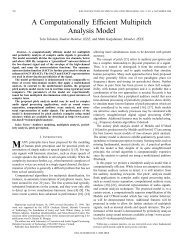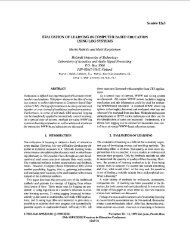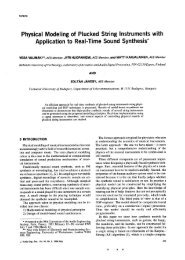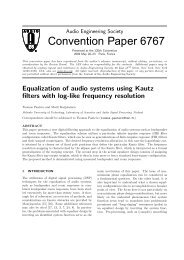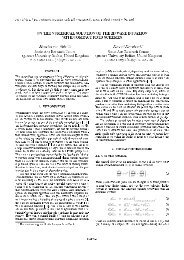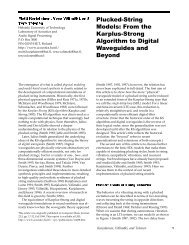Splitting the Unit Delay - IEEE Signal Processing ... - IEEE Xplore
Splitting the Unit Delay - IEEE Signal Processing ... - IEEE Xplore
Splitting the Unit Delay - IEEE Signal Processing ... - IEEE Xplore
You also want an ePaper? Increase the reach of your titles
YUMPU automatically turns print PDFs into web optimized ePapers that Google loves.
method but also irrespective of <strong>the</strong> amplitude curve approximated.This suggests that <strong>the</strong> Oetken method can be used tocontrol <strong>the</strong> delay of any FIR filter. This is, however, onlypossible when <strong>the</strong> zeros of <strong>the</strong> error function are knownbeforehand so that <strong>the</strong> transformation matrix (which onlydepends on <strong>the</strong> zeros) can be computed.3) Farrow Structure for Fractional <strong>Delay</strong> FIR FiltersA promising technique for efficient implementation of acontinuously variable delay element was proposed by Farrow[29]. This method assumes that <strong>the</strong> filter is designed off-line,but <strong>the</strong> real-time control of <strong>the</strong> delay value is simple andefficient. The basic idea is to design a set of filters approximatinga fractional delay in <strong>the</strong> desired range (e.g., 0s dG1) and <strong>the</strong>n to approximate each coefficient as a Pth-orderpolynomial of d, or'. The Furrow structure for implementation of polynoimiul upproximationoffilter coeflcients.delay control Can be formulated as follows:1) Design a set of Q + 1 FIR filters of <strong>the</strong> (same) chosenorder N approximating in a desired sense <strong>the</strong> ideal nonintegerdelay whose fractional part takes values in <strong>the</strong> desired range[dmi,, dmax]. The values of d can be chosen, for example, on auniform grid as(59)where c,(n) are real-valued approximating coefficients. Thesubscript d is now included to emphasize that each coefficientis a function of <strong>the</strong> fractional delay, d. The transfer functionof <strong>the</strong> filter can be elaborated into <strong>the</strong> formThe result is <strong>the</strong> set of prototype filters with <strong>the</strong> coefficientshd,q(n) for q = 0, 1,2, ..., Q and n = 0, 1,2, ..., N.2) Design <strong>the</strong> polynomial structure approximating <strong>the</strong>coefficients of <strong>the</strong> prototype filters in <strong>the</strong> desired sense so thatDhd,,(n) = xcm(n)d?, q = 0,1,2 ,..., Q; IZ = 0,1,2 ,..., Nm=O (63)where it was definedThe form (Eq. 60) immediately suggests an efficient implementationas a parallel connection of fixed filters withoutput taps weighted by an appropriate power of d (Fig. 7).The sample implementation presented in [29] was designedby employing least squared error criterion over <strong>the</strong>desired frequency band and <strong>the</strong> employed range of d. Also<strong>the</strong> polynomial approximation of <strong>the</strong> filter coefficients wasdone in <strong>the</strong> least squares sense. An excellent tutorial presentationof <strong>the</strong> method with examples and performance analysisis included in [721, when applied to timing adjustment algorithmsin digital receivers.The polynomial approach can readily be generalized foro<strong>the</strong>r filter design techniques as well. In addition to <strong>the</strong> leastsquares method, maximally flat or equiripple approximationcan be employed to design <strong>the</strong> set of prototype filters covering<strong>the</strong> desired range of d. The coefficients of <strong>the</strong> filter set are<strong>the</strong>n approximated separately by <strong>the</strong> polynomial structure ofa desired order. Polynomial interpolation techniques, such asLagrange interpolation, can be realized using <strong>the</strong> Farrowstructure without fur<strong>the</strong>r approximation [27], [ 1261, [130],[135].The design of <strong>the</strong> generalized polynomial structure forNote that <strong>the</strong> design reduces to L = N + 1 separate optimizationproblems: each polynomial approximation is carriedout for a fixed value of n. It is easiest to use least squares curvefitting for this task. According to our experience, second-orderpolynomials with three coefficients are usually sufficient.The resulting coefficients c,(n) are <strong>the</strong>n employed to form<strong>the</strong> transfer functions Cm(z) of <strong>the</strong> subsections, as shown inFig. 7.We applied <strong>the</strong> design method to imitate <strong>the</strong> response of4-tap equiripple approximations of Fig. A6. Second-orderpolynomials (P = 2) were used for coefficient approximation.The results are shown in Figs. 8a and 8b, which show thatboth <strong>the</strong> amplitude and phase delay characteristics are accuratelyreproduced, with hardly any observable deviation from<strong>the</strong> original ones (Figs. A6a and b). Similar results wereobtained for 10-tap filters. Farrow approximation with second-orderpolynomial approximation for coefficients thusprovides an accurate means for practical implementation ofFIR FD filters.The polynomial approximation technique can also be appliedto allpass filters, as will be discussed shortly.Summary of FIR Filter Design and ImplementationTo conclude our discussion of FIR FD filters, we present asummary of <strong>the</strong>se techniques and evaluate <strong>the</strong>ir design complexity.As stated previously, our main interest is in faston-line tuning of <strong>the</strong> fractional delay and thus <strong>the</strong> fast updateof <strong>the</strong> coefficients is of paramount importance.JANUARY 1996 <strong>IEEE</strong> SIGNAL PROCESSING MAGAZINE 45






